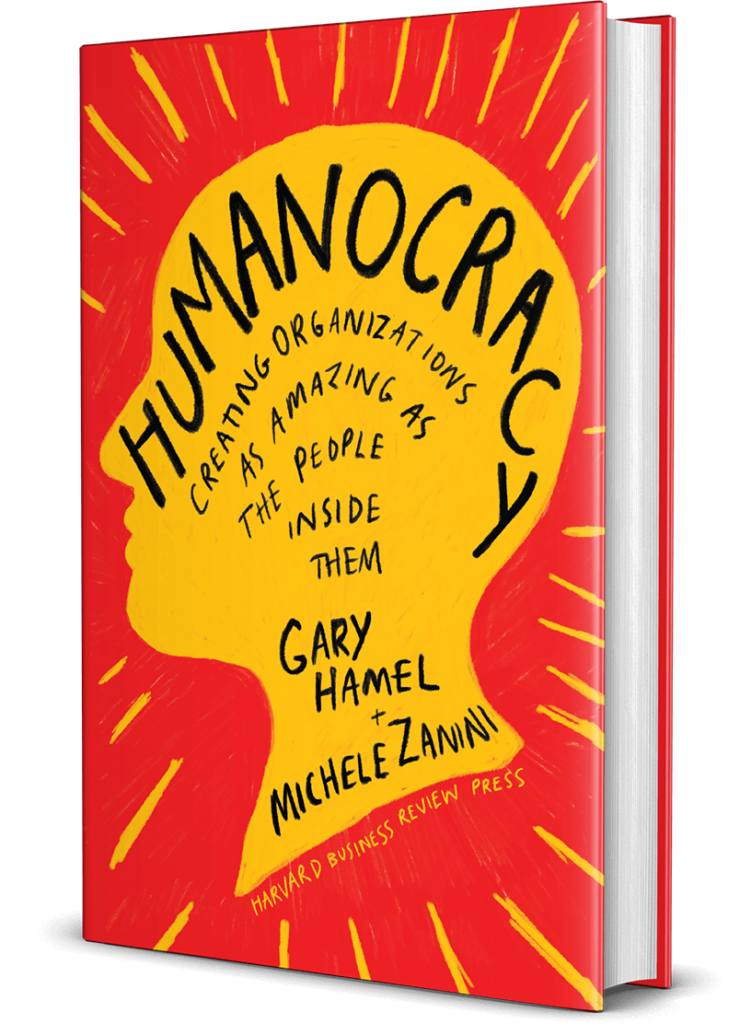Humanocracy by Gary Hamel and Michele Zanini
About the book “Humanocracy – Organizations which are fit for the future and fit for human beings”. A book that influenced my thinking.
In the last six months, I’ve come across Humanocracy and a few other books, each of which are very interesting on their own, but which, for me, have combined to provide some new insights into agile as a whole. I actively use the concepts in my management seminars.
I want to share those and this is the first blog in that series.
The title “Humanocracy” is on the one hand ambition and program, on the other hand also a demarcation. The program becomes clear with the subtitle: “Organizations which are fit for the future and fit for human beings”. For me, the delineation comes in the title, in which a new term is coined rather than latching onto an existing one.
Both claims are justified and well-founded for me, alongside a clear exposition of the concepts come many stories about what is possible and how working with respect affects people’s work and productivity.

The authors start with the observation that rules and structures, which they summarize as bureaucracy, have steadily expanded over the past decades and have now reached an unreasonable dominance. As a result, they hinder pleasant work, creativity, innovation and ultimately productivity.
They propose a few concepts as components of “humanocracy” that lead to an organization with more participation and, at the same time, more flexibility:
- Alignment with principles instead of superficial appearances
- Strengthening Ownership. This is more than participation, it is taking responsibility and initiative.
- More internal markets instead of monopolies and compliance
- Meritocracy
- Create and strengthen communities as informal bodies
- Use openness and its effect
- dare more experiments
- Relating life with paradoxes, i.e. the need for rules (and thus bureaucracy) on the one hand and working with informal, creative ones on the other hand
The authors support their theses with a lot of practical examples from large (American) organizations. What is interesting about this is that the examples from organizations in particular are almost all not from IT areas.
What I take with me
- the examples and also the descriptions show how you can use many different starting points to build structures that are “good for human beings”. They’re really strong evidence that innovation can start from anywhere.
- The ideas for starting now encourage you to start now. They counter the classic model of implementing change from the top down with a “hack your organization” approach. They give the reader a list of concrete ideas for first steps that is worth reading.
- The management model is described as holistic responsibility, without the distinction between leadership and management (which they call hype). I still think the distinction is important, but I take the hint that it is a holistic task – and not just for leadership personnel – as a litmus test for my distinction.
How to use humanocracy practically
In addition to the great end-to-end view of organizations, it also has many direct tie-ins for work:
- You can do a self-assessment of the organization on their BMI, their bureaucracy mass index and get ideas for hotspots and appropriate starting points
- One can use the specific ideas on each topic (e.g., meritocracy in the chapter on “The power of meritocracy”). They are broken down to mirror strokes – I don’t say checklists, they are lists of ideas.
- One can adopt the view of a “hacker,” that is, of someone who boldly starts experiments in his field, even if he does not (yet?) have permission to do so.
Three management books that have influenced me
In the last six months, I’ve come across a couple of books that are each very interesting on their own, but together have provided me with some new insights into agile as a whole.
The first is“Humanocracy” by Gary Hamel and Michele Zanini. It’s new, and I’ve been a fan of Gary Hamel for a long time. That came primarily via his wonderful talk on YouTube, “The Future of Management.”
I discovered the second book, “The infinite Game” by Simon Sinek quite banally in the recommendations that Amazon displays with every purchase. I know Simon Sinek through his concept “The golden Circle”, also known as “Start with Why”, which I use regularly, both as a tool for my own work and as an important building block in my leadership trainings. He has many talks on this on Youtube; I recommend the first seven minutes of “Most Leaders Don’t Even Know the Game They’re In” – they’re not complete, but are enough to trigger an addiction for more.
The third book, “From Good to Great” by Jim Collins, had been sitting in my inbox for so long that I had almost forgotten about it. It’s actually quite old, dating from 2001, but that’s what made it particularly relevant to me: it’s not one of those “me too” books, and it makes clear that the book’s theses are based on long hard empirical work. Therefore, it was a “second view” for me, which made some terms and concepts from agile sharper or put them in a new light.